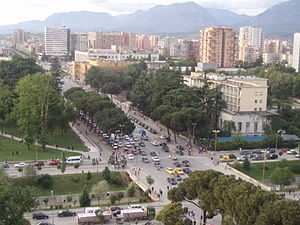Rinia Park
| Rinia Park | |
|---|---|
 Rinia Park shown to the left beyond the crossroads. Skanderbeg Square to the north in the heart of Tirana | |
 | |
| Type | Park |
| Location |
Tirana, |
| Created | 1950 |
Rinia Park (Albanian: Parku Rinia) is the central public park of Tirana, Albania, built in 1950 during the socialist system of government, covers an area of 29.81 hectares.[1][2]
Every year on March 14, this park is one of the many venues of the Summer Festival, a national festival celebrating cultural heritage that symbolizes the end of winter and the start of nature's freshness. On this occasion circus acrobats and show performers entertain people in the park.
The park was rebuilt in 2000, with a new green area and water feature, after years of degradation.
Geography
The park, 500 m from the central square, is bordered by Dëshmorët e Kombit Boulevard to the east, Bulevardi Gjergi Fishta and Bajram Curri Boulevard to the south, Rruga Deshmoret e 4 Shkurit to the west and Rruga Myslym Shyri to the north.[1][3][4] Immediately to the north is the Teatri i Kukullave and the Orthodox Cathedral. The Taivani restaurant and water feature are located in the western perimeters of the park.
History
Rinia Park was built in 1950[5] as part of a major urban development program which developed after World War II. It was initially a pleasant family park where inhabitants of Tirana could take their children.[2][6] In 1991, after the end of communism, illegal shabby buildings sprang up all around the park; this was made possible by bribery. Most of these buildings were privately owned kiosks, bars and restaurants,[6] and as a result the park became a notorious hang-out for Tirana's drug lords, dealers and other shady businesses.[6][7]
During the period a café and restaurant complex were also built in the park. During the city's cleanup in 2000, these buildings were razed and the park was replanted.[7] All in all, some 130 buildings were demolished and over 45,000 cubic meters of waste removed.
Taivani

As a result of total restoration of the park, Tiranians flock to the park in the evenings to enjoy the many attractions such as the Spider-shaped white building (compared to a typical James Bond film villain’s den), fountains, restaurants, a Swiss terrace café called the Taiwan cafe or Taivani and underground bowling. Taivani is the most prominent landmark in the park, one of Tirana's most modern and frequented restaurants which has a water feature. It is known as Taivani or "Taiwan" as it is said to resemble the island of Taiwan. It was named so to mark the break of Albania's diplomatic relations with mainland China and recognition of Taiwan as in independent country (Albania is said to be the first country to do so).[1][2][8]
Summer Festival
Every year on March 14, the people of Tirana and Albania have the Summer Festival, their largest pagan festival which is intended to celebrate the end of winter, the rebirth of nature and a rejuvenation of spirit amongst the Albanians. Although the epicentre of this festival is in Shkumbin (Elbasan), the festival is widely celebrated in Tirana and as far afield as the Arbëresh colonies in Italy. In Tirana many festivities are organized including a city marathon and are generally performed between 9 am and 9 pm. In Rinia Park, a circus show is put on the evenings and is packed with circus performers, acrobats, magicians, and people celebrating the festival.[9]
References
- ↑ 1.0 1.1 1.2 Marle, Jeroen van; Alwyn Thomson. Tirana In Your Pocket. In Your Pocket. p. 24. Retrieved 2010-11-02.
- ↑ 2.0 2.1 2.2 "Post –Socialist City Development in Tirana". Roskilde Universitetscenter. 2006. Retrieved 2010-11-02.
- ↑ Google. Google Maps (Map).
- ↑ Microsoft and Harris Corporation Earthstar Geographics LLC. Bing Maps (Map).
- ↑ "Albania sites". Lura Tours. Retrieved November 1, 2010.
- ↑ 6.0 6.1 6.2 Peter Lucas (2002). Rumpalla. Xlibris Corporation. p. 202. ISBN 1-4010-4534-0.
- ↑ 7.0 7.1 Jeroen van Marle, Alwyn Thomson. Tirana In Your Pocket. In Your Pocket. p. 25.
- ↑ Tony Wheeler (2007). Tony Wheeler's bad lands. Lonely Planet. p. 60. ISBN 1-74179-186-3.
- ↑ "Summer Day magic as Albania celebrates its biggest pagan festival". mesdimr. March 2008. Retrieved 2010-11-02.
Coordinates: 41°19′29″N 19°49′5″E / 41.32472°N 19.81806°E